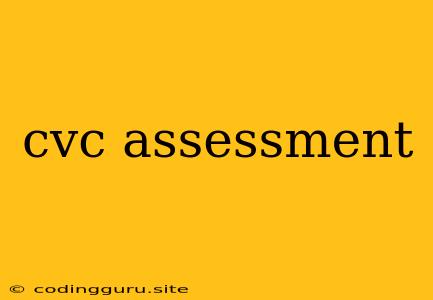What is a CVC Assessment and Why is It Important?
CVC assessment, also known as consonant-vowel-consonant assessment, is a critical component of early literacy development. It focuses on a child's ability to decode and encode simple words that follow the CVC pattern. These words consist of a single consonant sound, followed by a vowel sound, and then another consonant sound.
Why is CVC Assessment Important?
CVC assessment plays a vital role in identifying a child's foundational reading skills. It helps teachers and parents understand:
- Phonological awareness: A child's ability to hear and manipulate sounds in words.
- Decoding skills: The ability to break down words into their individual sounds and blend them together to read.
- Encoding skills: The ability to write down words by representing their sounds.
By assessing these skills, educators can tailor their instruction to meet individual needs, promoting early literacy success.
How is CVC Assessment Conducted?
CVC assessments can be conducted in a variety of ways, including:
- Formal assessments: Standardized tests specifically designed to measure CVC knowledge. These tests often include multiple-choice questions, picture matching, and word-reading tasks.
- Informal assessments: Observations and activities conducted in the classroom or at home. These can include:
- Word recognition: Asking the child to read a list of CVC words.
- Sound blending: Asking the child to blend individual sounds together to form a word.
- Sound segmentation: Asking the child to break a word into its individual sounds.
- Picture-word matching: Showing the child a picture and asking them to point to the corresponding CVC word.
How to Help Children Develop CVC Skills
Developing strong CVC skills is essential for successful reading and writing. Here are some tips for helping children:
- Focus on phonemic awareness: Engage children in activities that enhance their ability to hear and manipulate sounds in words. This can include rhyming games, sound isolation, and sound blending activities.
- Introduce CVC words gradually: Start with simple words like "cat," "dog," and "sun." Gradually introduce more complex CVC words as the child progresses.
- Use multisensory learning: Incorporate visual, auditory, and kinesthetic approaches to learning CVC words. Use flashcards, manipulatives, and interactive games to make learning fun and engaging.
- Encourage reading and writing practice: Provide opportunities for children to practice reading and writing CVC words in a variety of contexts. This can include reading books with CVC words, writing simple sentences, and playing word games.
Examples of CVC Assessment Activities
Here are some examples of CVC assessment activities you can use at home or in the classroom:
Sound Blending:
- "What word do you hear when I say /c/ /a/ /t/?"
- "Can you blend these sounds together: /m/ /a/ /n/?"
Sound Segmentation:
- "What sounds do you hear in the word 'dog'?"
- "Can you tell me the sounds in the word 'bed'?"
Word Recognition:
- Show a list of CVC words and ask the child to read them.
- Use picture cards with CVC words and ask the child to match the word to the picture.
Word Building:
- Provide magnetic letters or letter tiles and ask the child to build CVC words.
- Give the child a set of CVC words and ask them to arrange them in alphabetical order.
Conclusion
CVC assessment is a valuable tool for identifying and supporting a child's early literacy development. By understanding a child's knowledge of CVC words, educators and parents can provide appropriate instruction and support to help them become confident readers and writers. By focusing on phonemic awareness, decoding and encoding skills, and providing ample practice opportunities, children can develop strong CVC skills that form the foundation for literacy success.
